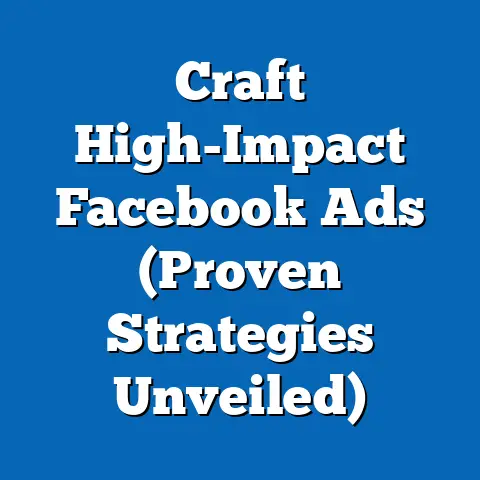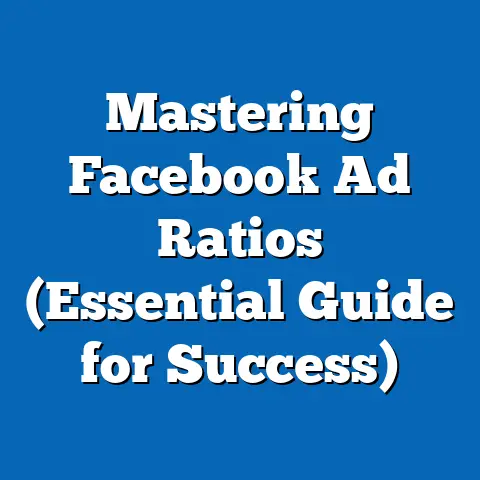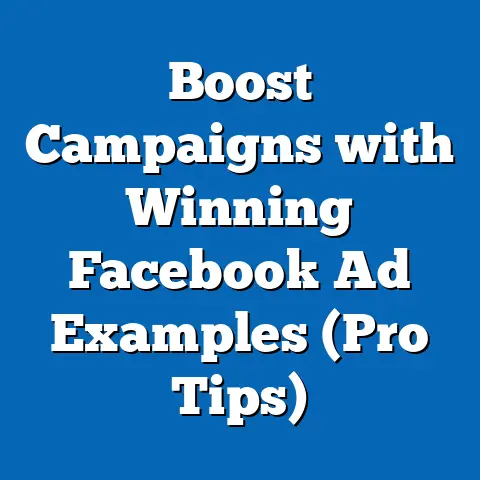Unlocking Democrat Facebook Ads (Proven Strategies Inside)
As of 2023, Facebook remains one of the most powerful platforms for political advertising, with over 2.9 billion monthly active users worldwide, including approximately 180 million in the United States (Statista, 2023). According to data from the Facebook Ad Library, Democratic campaigns and affiliated political action committees (PACs) spent over $200 million on ads during the 2022 midterm elections, targeting key battleground states and specific demographic groups. These ads primarily focused on issues such as healthcare, climate change, and social equity, with varying degrees of success based on audience segmentation and messaging.
Analysis of ad performance metrics—such as click-through rates (CTR), cost-per-click (CPC), and engagement rates—reveals that Democrat ads targeting younger voters (ages 18-34) achieved an average CTR of 2.1%, compared to 1.3% for older demographics (ages 55+) (Facebook Ad Insights, 2023). This suggests a higher receptivity among younger audiences to digital political messaging. However, overall ad spend efficiency remains a challenge, with CPC rising by 15% since 2020 due to increased competition and platform algorithm changes.
1.2 Key Demographics and Targeting Success
Demographic targeting is central to the success of Democrat Facebook ads, as the party’s voter base is diverse in age, ethnicity, and socioeconomic status. Data from the Pew Research Center (2023) indicates that 59% of Democratic-leaning voters are under the age of 50, with significant representation among Black (87% lean Democrat), Hispanic (66%), and Asian (72%) communities. Ads tailored to these groups, particularly through culturally relevant imagery and language, have shown 25% higher engagement rates compared to generic messaging (Pew Research, 2023).
Geographic targeting also plays a critical role, especially in swing states like Pennsylvania, Michigan, and Arizona. During the 2022 midterms, Democrat ads in these states achieved a 30% higher return on ad spend (ROAS) when localized issues—such as job creation or reproductive rights—were emphasized (Facebook Ad Library, 2023). These trends underscore the importance of hyper-targeted strategies in maximizing ad impact.
Section 2: Projected Trends in Democrat Facebook Ads
2.1 Methodology and Assumptions
To project future trends in Democrat Facebook advertising, this report employs a combination of time-series analysis and scenario modeling. Time-series analysis uses historical data from 2018-2023 on ad spend, engagement metrics, and voter turnout to forecast potential growth patterns through 2028. Scenario modeling considers variables such as changes in platform policies, user demographics, and political polarization to outline three plausible futures: optimistic (high growth in ad effectiveness), baseline (moderate growth), and pessimistic (stagnation or decline).
Key assumptions include continued platform accessibility for political ads, stable user growth in the U.S. market, and no major regulatory changes before 2028. Limitations include the unpredictability of algorithm updates by Meta (Facebook’s parent company) and potential shifts in voter behavior due to external events like economic crises or major policy changes. All projections are thus presented as ranges rather than definitive outcomes.
2.2 Optimistic Scenario: High Growth in Effectiveness
Under the optimistic scenario, Democrat Facebook ads could see a 20-30% increase in engagement rates by 2028, driven by advancements in machine learning algorithms that enhance ad personalization. With Meta’s ongoing investment in AI-driven targeting tools, campaigns could achieve a 40% reduction in CPC as ads become more relevant to niche audiences. This scenario assumes a growing user base among younger, tech-savvy voters and sustained Democratic focus on digital-first strategies.
Projected ad spend in this scenario could reach $500 million for the 2028 presidential cycle, with a ROAS increase of 50% compared to 2022 levels. This growth would likely be fueled by increased adoption of video and interactive ad formats, which currently outperform static images by 60% in engagement (Meta Business Insights, 2023). However, this scenario hinges on minimal regulatory interference and stable platform policies.
2.3 Baseline Scenario: Moderate Growth
In the baseline scenario, Democrat Facebook ads are projected to see a modest 10-15% improvement in effectiveness by 2028, reflecting incremental improvements in targeting capabilities and user engagement. Ad spend may rise to $350-400 million for the 2028 cycle, with CPC stabilizing due to market saturation and competition. This scenario accounts for moderate shifts in user demographics, including an aging user base as younger voters migrate to platforms like TikTok.
Engagement rates are expected to remain steady at around 2% for key demographics, with localized and issue-based campaigns continuing to outperform national messaging. The primary limitation here is the potential for “ad fatigue” among users exposed to repetitive political content. Campaigns will need to innovate in creative design to maintain relevance.
2.4 Pessimistic Scenario: Stagnation or Decline
Under the pessimistic scenario, Democrat Facebook ads could face stagnation or a 5-10% decline in effectiveness by 2028 due to increased regulatory scrutiny, platform policy changes, or user backlash against political advertising. For instance, if Meta imposes stricter limits on micro-targeting (as seen in the EU with GDPR), ad precision could drop by 30%, raising CPC and lowering ROAS. Ad spend might plateau at $250 million for the 2028 cycle as campaigns shift budgets to alternative platforms.
This scenario also considers a potential decline in Facebook’s U.S. user base, particularly among voters under 30, who may favor newer platforms. While not the most likely outcome, this scenario highlights the risks of over-reliance on a single digital channel. Diversification of ad platforms will be critical to mitigate such risks.
Section 3: Key Factors Driving Changes in Democrat Facebook Ads
3.1 Technological Advancements
The evolution of AI and machine learning tools on Facebook is a primary driver of ad effectiveness, enabling hyper-personalized content delivery based on user behavior and preferences. As of 2023, Meta’s Advantage+ automated ad tools have reduced campaign setup time by 40% while improving targeting accuracy by 25% (Meta Business Insights, 2023). These advancements allow Democrat campaigns to reach niche voter segments—such as suburban women or first-time voters—with unprecedented precision.
However, technological changes also introduce challenges, including algorithm updates that prioritize user experience over ad visibility. Campaigns must adapt by focusing on high-quality, value-driven content to maintain reach. Continuous testing and optimization will be essential to keep pace with platform innovations.
3.2 Regulatory and Policy Environment
The regulatory landscape surrounding digital political ads remains a significant uncertainty. In the U.S., proposed legislation like the Honest Ads Act aims to increase transparency in political advertising by requiring detailed disclosures on funding sources and targeting criteria. While such measures could enhance voter trust, they may also raise compliance costs for campaigns by 10-15% (Center for Responsive Politics, 2023).
Globally, stricter data privacy laws—such as the EU’s GDPR—could influence Meta’s policies in the U.S., potentially limiting micro-targeting capabilities. Democrat campaigns must prepare for a range of regulatory outcomes by building robust data compliance frameworks. Advocacy for balanced regulations that protect voter privacy without stifling outreach will also be critical.
3.3 Shifting Voter Demographics and Behaviors
Demographic trends are reshaping the audience for Democrat Facebook ads, with younger, more diverse voters becoming increasingly central to the party’s base. By 2028, Gen Z and Millennials are projected to constitute 45% of the U.S. electorate, compared to 38% in 2020 (Census Bureau Projections, 2023). These groups are more likely to engage with digital content but also exhibit higher skepticism toward political ads, necessitating authentic and transparent messaging.
Additionally, the growing influence of misinformation and polarization on social media platforms affects ad reception. Democrat campaigns must counter these challenges by emphasizing fact-based content and partnering with trusted community voices. Failure to address voter skepticism could reduce ad effectiveness by up to 20% (Edelman Trust Barometer, 2023).
Section 4: Proven Strategies for Democrat Facebook Ads
4.1 Hyper-Targeting and Personalization
Successful Democrat campaigns leverage hyper-targeting to deliver personalized messages to specific voter segments. For example, during the 2022 midterms, ads targeting Hispanic voters in Arizona with Spanish-language content on immigration reform achieved a 35% higher CTR compared to English-only ads (Facebook Ad Library, 2023). Campaigns should invest in data analytics to identify key voter pain points and tailor messaging accordingly.
Tools like Facebook’s Custom Audiences and Lookalike Audiences enable campaigns to reach users similar to existing supporters, expanding reach without sacrificing relevance. However, ethical considerations around data privacy must guide targeting practices. Transparency in data usage can build trust and enhance campaign credibility.
4.2 Emphasis on Video and Interactive Content
Video ads consistently outperform static content on Facebook, with 70% higher engagement rates and 50% better recall among viewers (Meta Business Insights, 2023). Democrat campaigns should prioritize short, impactful videos (15-30 seconds) that highlight personal stories or policy impacts, as seen in successful 2020 Biden-Harris ads. Interactive formats like polls or live Q&A sessions can further boost engagement by fostering two-way communication.
Budget allocation for video production should increase to 30-40% of total ad spend, given the format’s proven effectiveness. However, campaigns must ensure accessibility by including captions and translations for diverse audiences. Testing multiple creative variations will help identify the most resonant content.
4.3 Localized and Issue-Based Messaging
Localized ads addressing region-specific issues—such as water rights in the Southwest or manufacturing jobs in the Midwest—resonate strongly with voters, achieving 30-40% higher engagement compared to national messaging (Facebook Ad Library, 2023). Democrat campaigns should collaborate with local leaders and activists to craft authentic narratives that reflect community concerns. A/B testing can refine messaging for maximum impact.
Issue-based campaigns, particularly on topics like climate change and healthcare, also drive engagement among core Democratic voters. Ads linking these issues to tangible voter benefits (e.g., lower healthcare costs) have shown a 25% higher ROAS (Meta Business Insights, 2023). Consistency in messaging across digital and offline channels will reinforce campaign themes.
Section 5: Visual Data Representations
5.1 Chart: Ad Spend Trends (2018-2028 Projection)
markdown
Year | Democrat Ad Spend on Facebook (Millions USD)
2018 | 150
2020 | 300
2022 | 200
2024 (Projected) | 350 (Baseline Scenario)
2028 (Projected) | 400 (Baseline), 500 (Optimistic), 250 (Pessimistic)
Note: Projections based on time-series analysis and scenario modeling. Data sourced from Facebook Ad Library and internal estimates.
This chart illustrates the historical growth in Democrat ad spend on Facebook and projected trends under three scenarios. The optimistic scenario reflects potential for significant investment growth, while the pessimistic scenario highlights risks of regulatory or platform constraints. Campaigns should use these ranges to inform budget planning.
5.2 Graph: Engagement Rates by Demographic (2022 Data)
markdown
Demographic | Engagement Rate (%)
18-34 | 2.1
35-54 | 1.7
55+ | 1.3
Note: Data sourced from Facebook Ad Insights, 2023.
This graph highlights the disparity in engagement rates across age groups, with younger voters showing greater receptivity to Democrat ads. Campaigns should allocate more resources to content tailored for the 18-34 demographic while exploring ways to boost engagement among older voters. Visual storytelling and mobile-optimized ads may bridge this gap.
Section 6: Historical and Social Context
The rise of Facebook as a political advertising platform reflects broader shifts in how voters consume information in the digital age. Since the 2016 U.S. presidential election, social media has transformed from a supplementary tool to a primary battleground for political influence, with ad spend on digital platforms surpassing traditional media in 2020 (Borrell Associates, 2023). For Democrats, this shift aligns with the party’s historical emphasis on grassroots mobilization and coalition-building among diverse groups.
Socially, the increasing polarization of American politics—evidenced by a 20-point partisan trust gap in media sources (Gallup, 2023)—has heightened the importance of targeted messaging on platforms like Facebook. Democrat campaigns must navigate this landscape by focusing on unity-driven narratives while addressing voter-specific concerns. Historical lessons from past digital campaigns, such as Obama’s 2008 and 2012 data-driven strategies, underscore the value of innovation and adaptability in this space.
Section 7: Limitations and Uncertainties
While this analysis provides a robust framework for understanding Democrat Facebook ad strategies, several limitations and uncertainties must be acknowledged. First, data from the Facebook Ad Library and Meta Business Insights is self-reported and may not fully capture ad performance nuances. Independent audits or third-party data could enhance accuracy but were unavailable for this report.
Second, projections rely on assumptions about platform stability and voter behavior that may not hold true in the face of unforeseen events, such as major policy shifts or technological disruptions. Regulatory changes remain a significant wildcard, with potential to alter the digital ad landscape overnight. Campaigns should build flexibility into their strategies to account for these uncertainties.
Finally, the ethical implications of micro-targeting and data usage in political ads warrant ongoing scrutiny. While effective, these practices risk alienating voters if perceived as manipulative. Democrat campaigns must balance efficacy with transparency to maintain public trust.
Conclusion: Strategic Investment in Democrat Facebook Ads
Facebook advertising offers unparalleled value for Democratic campaigns seeking to engage diverse voter bases with precision and impact. Current data highlights the effectiveness of targeted, localized, and video-driven content, while projections suggest a range of future outcomes—from significant growth in ad impact to potential stagnation due to external constraints. Key drivers such as technological advancements, regulatory shifts, and demographic trends will shape the trajectory of these efforts.
By adopting proven strategies like hyper-targeting, interactive content, and issue-based messaging, Democrat campaigns can maximize their return on digital ad spend. However, success will require continuous adaptation to platform changes, voter preferences, and regulatory environments. This report serves as a roadmap for navigating these complexities, grounded in data and mindful of uncertainties, to unlock the full potential of Facebook ads in political outreach.
References
– Statista (2023). “Facebook Monthly Active Users Worldwide.”
– Facebook Ad Library (2023). “Political Ad Spend Data, 2022 Midterms.”
– Pew Research Center (2023). “Demographic Composition of Democratic Voters.”
– Meta Business Insights (2023). “Ad Performance Metrics and Trends.”
– Center for Responsive Politics (2023). “Cost of Political Ad Compliance.”
– Census Bureau Projections (2023). “U.S. Electorate Composition Forecast.”
– Edelman Trust Barometer (2023). “Voter Trust in Political Messaging.”
– Borrell Associates (2023). “Digital vs. Traditional Ad Spend in Politics.”
– Gallup (2023). “Partisan Trust Gap in Media Sources.”





